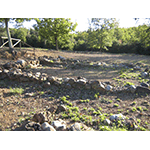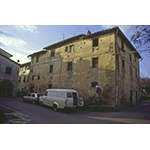Unbaked clay buildings in Tuscany

Even today, most of the houses in the world seem to be built of unbaked clay. Certainly, in Western World, the use of unbaked clay has been restricted mainly to buildings of low economic value and modest extraction.

Building techniques and materials
Archaeology furnishes almost exclusively information on the buildings that were constructed of stone or baked bricks in antiquity. The multiplicity of ways in which simple sun-dried clay can be used may make it harder to imagine, in modern times, that part of the existing architectural heritage which was built of neither stones nor baked bricks.
An awareness of this fact and the publication of an abundant bibliography dedicated to this subject has come mainly from the work of CRATerre, the research laboratory and teaching team of the Grenoble School of Architecture.
Buildings made of unbaked clay are constructed by various techniques depending on the composition of the soil and the climate of the place in question: pisť, that is, clay directly pressed in formworks to be disassembled, when the clay is leaner; adobe, that is, big blocks of clay, usually with the addition of straw and plant fibres, when the clay is oily; clods of mud added one by one in building the walls, and then carefully spread, in the drier climates; reed matting saturated with clay for filling in the walls of houses with wooden structures, in northern Europe.

Testimony of unbaked clay architecture in Tuscany
In the Tuscan territory as well, innumerable examples of unbaked clay constructions exist, of which the inhabitants themselves are often unaware. In fact, a type of unbaked brick entirely similar in both composition and size to those produced for baking predominates. It is often found along with baked bricks that have been used to replace ruined parts or have been added due to subsequent building requisites. Carefully covering them with plaster, which allows the adaptation of this technique to our relatively rainy climates, seals the secret.
The use of unbaked clay in building rural constructions was fervently promoted by Giuseppe Del Rosso, a member of the Georgofili who published the pamphlet Dell'economica costruzione delle case di terra [Concerning the economical construction of clay houses] in 1793. The author stated that there were many buildings made of unbaked clay "in the Val di Chiana, in the upper and lower Provinces of Siena, in the upper Val d'Arno, etc." dating from the late 15 th century, and expressed the hopes that this building technique would be revived, for the purpose of providing low-cost housing and satisfying the demand.
Buildings made of adobe have recently been noted; for example, the Infernuzzo farm, the ruins of the Scuragnolo farm and the hay-barn of the Coltolungo farm in the vicinity of Terranuova Bracciolini, in which some parts of the masonry on the first floors are made of unbaked bricks bound with a weak lime plaster mix. In the town of Terranuova Bracciolini are various structures made of adobe; examples of pisť masonry have been reported in the town of S. Giovanni Valdarno and in the Town Hall of Montelupo.
In particular, the pisť technique predominates in Val di Chiana, where the clay is leaner and thus more suitable for moulding elements of structural size. The use of unbaked clay in these territories must have been a common practice for rural houses, as proven by the numerous examples still visible around Cortona. They are buildings now abandoned or used to house services, like the one found in the Appalto locality (S. Lorenzo), on the Lauretana provincial road, and the one at S. Agata (Fratta).
****************************
Texts by Giovanna Ranocchiai
English translation by Catherine Frost
Last update 16/giu/2011


